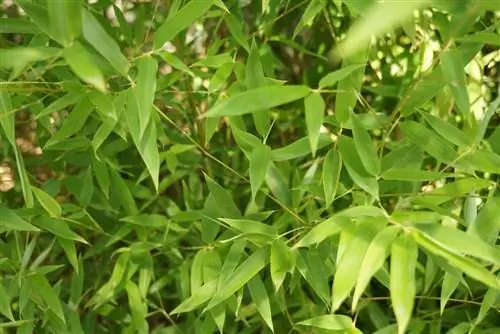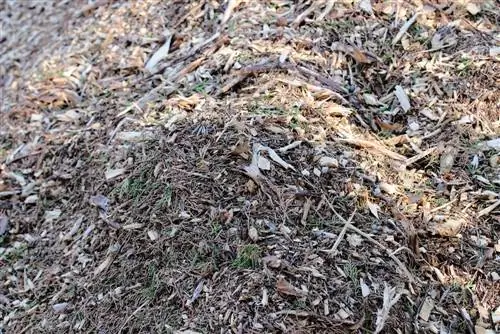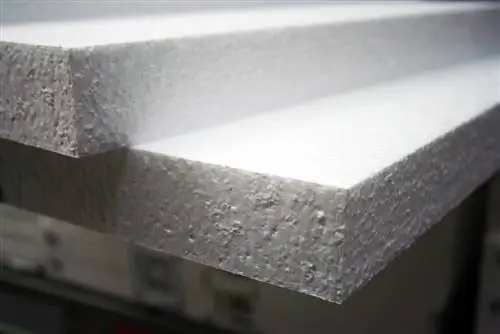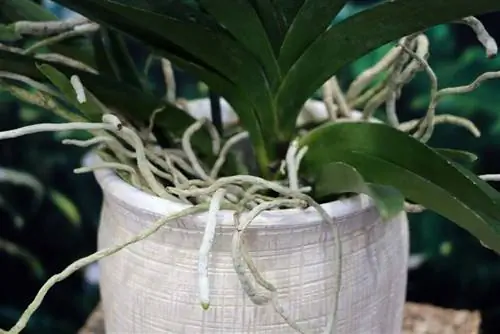- Author admin [email protected].
- Public 2023-12-17 03:39.
- Last modified 2025-01-24 12:45.
These prevent an inflationary spread of the bamboo, whose rhizomes often do not form immediately after the first planting, but can take a few years before they are noticed. The runners can appear several meters away from the mother plant. Bamboo also grows where there are stones or across your own property boundaries. Therefore, the bamboo can be prevented from spreading in advance by installing rhizome barriers. For this purpose, a ring made of polyethylene, i.e. plastic, is placed in the ground around the plant or the roots of the plant. Care should be taken to ensure that the film has a thickness of at least 2 mm.
Bamboo vs. Japanese Knotweed
Japanese knotweed is similar to bamboo. It also spreads through the garden through rhizomes and has similar stems. However, the knotweed dies on the surface in autumn while the rhizomes can overwinter. However, knotweed has a different leaf shape than bamboo. Unlike bamboo, which has elongated leaves, knotweed has ovate and broad leaves. It should be noted that these rhizomes can reach a depth of up to three meters. If, when removing the bamboo, it turns out that the roots go very deep, it may be knotweed.
Ways to remove bamboo roots
Bamboo is a very tough and stubborn plant whose rhizomes are very difficult to remove. However, there are manual, biological and chemical ways to combat bamboo roots. However, this usually requires a lot of work and patience.
Manual removal of bamboo from the garden
To completely remove bamboo from the garden, all parts of the roots must be removed. If even a small piece of it remains, a new bamboo will develop and spread again in an inflationary manner. If the bamboo has spread out of your own stock, it is important to install a root barrier afterwards and thus limit the spread to the area in which the bamboo is actually allowed to grow. The subsequent insertion of a rhizome barrier is very complicated, as the bamboo has to be dug up with the complete rhizomes in order to then insert the root barrier. Only then is the bamboo replanted. The unwanted roots around it now have to be dug out by hand.
This is often made more difficult by other plants, which prevent the roots from being completely dug out. It therefore makes sense to dig up all the plants that should be preserved. The earth is then dug deep and thoroughly. New soil may need to be added. Only then can the previously removed plants be put back. It is important that the bamboo roots are not added to the garden's own compost, as they can spread again from here.
Covering garden sections
If rhizomes are spreading in an unplanted part of the garden, there are several ways to remove them:
- On the one hand, the bamboo roots can also be dug up here.
- On the other hand, there is the possibility of covering parts of the garden with paper, cardboard or newspapers.
However, a layer that is at least ten centimeters thick must be applied here. A thick black film, which is more than 2 cm thick, is then placed on top and secured. This layer remains on the earth for several months. Due to the deprivation of water, oxygen and light, the rhizomes usually die and other weeds have no chance of survival in this section of the garden. This method is great for gardens where nothing is planted or growing during the winter months. This is how you can take action against the bamboo roots from September to March.
Fighting bamboo with chemical agents
In addition to natural or manual methods, chemical weed killers can also be used. However, the use of weed killers is not very environmentally friendly and plants that should not be destroyed can also be affected. The products usually have to be used several times, as a single application is not enough to completely remove the roots of the bamboo. However, before the shoots can be treated with a weed killer, all visible bamboo parts, i.e. those above the ground, must be removed. To do this, you usually start with the leaves and then remove the stems of the bamboo. Only when only the tender shoots are left are the plants sprayed with the agent. However, in order to finally remove the roots, this treatment must be repeated several times, without there being any real guarantee of success, as bamboo is a very strong plant that can survive even under adverse circumstances.
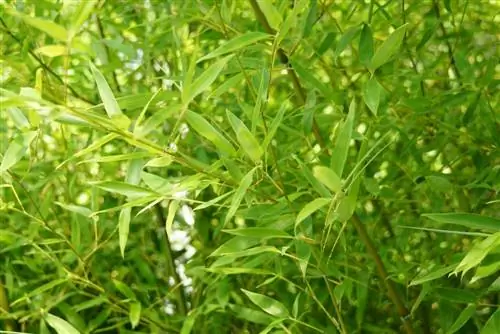
Bamboo roots can be removed using several methods. The manual methods are more effective than the chemical methods, but they are very time-consuming and labor-intensive. In all cases, work must be done very carefully, otherwise the rhizomes will find a way to sprout stems and leaves again.
Bamboo Root Removal Tips Coming Soon
If a root barrier was neglected when planting the bamboo, the areas where the bamboo is not wanted must be freed from its root runners. Bamboo roots spread in all directions, so the entire area around a plant must be cultivated to contain the bamboo's growth.
- Since the stolons form to a depth of 60 cm, the ground must be excavated to this depth to expose the stolons.
- For a single plant, this can be done by hand with a spade, otherwise a small excavator would be recommended.
- After the runners have been exposed, they can be picked off with a spade and destroyed.
- If the bamboo is to be completely removed from the garden, it is important to destroy all runners, otherwise the plant could sprout again later.
- The dug up roots should not end up in the compost heap, because there they could sprout again and grow again.
- So that the uncontrolled spread of the bamboo roots does not start again, a root barrier can be installed around the plant.
- This is a plastic film that is placed upright in the ground around the plant and which cannot be penetrated by the bamboo roots.
- This rhizome barrier is best closed at the seams with an aluminum rail so that no roots can penetrate into other areas of the garden at this point.
- It should be at least 60 cm high and protrude a little from the ground in order to protect the area just below the surface.
- This outstanding piece can later be covered with some soil or a layer of mulch.
Conclusion about removing bamboo roots
In order to avoid having to fight the roots of the bamboo later with a lot of effort or to set a root barrier, there are also some types of bamboo that do not have this problem. The varieties of Fargesia do not form underground runners, while the biggest problems with bamboo roots usually arise with the various types of Phyllostachys.

